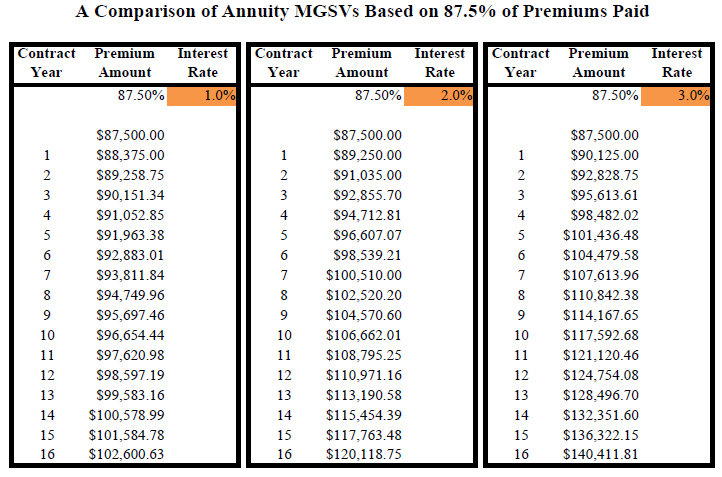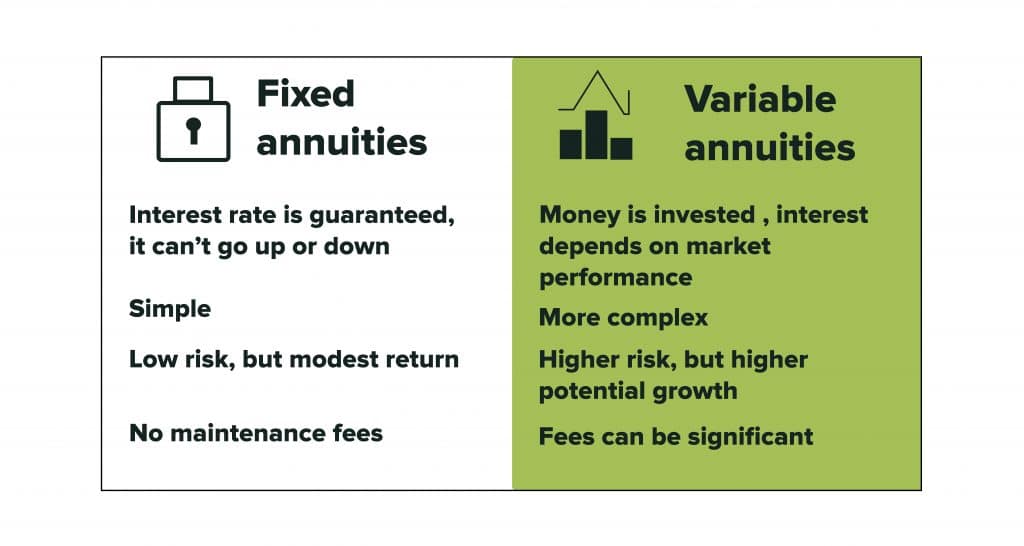All Categories
Featured
Table of Contents
The settlement may be invested for development for an extended period of timea solitary costs deferred annuityor invested momentarily, after which payout beginsa solitary costs instant annuity. Single costs annuities are usually funded by rollovers or from the sale of a valued property. A flexible costs annuity is an annuity that is meant to be moneyed by a collection of settlements.
Proprietors of dealt with annuities understand at the time of their acquisition what the worth of the future capital will be that are generated by the annuity. Clearly, the variety of capital can not be recognized in advance (as this relies on the agreement owner's life expectancy), yet the ensured, repaired interest price at the very least provides the proprietor some degree of assurance of future earnings from the annuity.
While this distinction appears straightforward and straightforward, it can considerably affect the value that a contract proprietor eventually acquires from his/her annuity, and it produces considerable unpredictability for the contract proprietor - Variable annuity subaccounts. It additionally normally has a product effect on the degree of charges that a contract owner pays to the providing insurer
Fixed annuities are often used by older investors who have restricted assets yet who intend to counter the danger of outlasting their assets. Fixed annuities can offer as an efficient device for this purpose, though not without specific downsides. In the case of instant annuities, as soon as an agreement has actually been bought, the agreement owner gives up any type of and all control over the annuity possessions.
Breaking Down Fixed Vs Variable Annuity Pros And Cons A Comprehensive Guide to Investment Choices Defining the Right Financial Strategy Features of Smart Investment Choices Why Choosing the Right Financial Strategy Is Worth Considering How to Compare Different Investment Plans: Explained in Detail Key Differences Between Different Financial Strategies Understanding the Risks of Long-Term Investments Who Should Consider Strategic Financial Planning? Tips for Choosing Variable Vs Fixed Annuity FAQs About Fixed Annuity Vs Equity-linked Variable Annuity Common Mistakes to Avoid When Choosing Fixed Annuity Or Variable Annuity Financial Planning Simplified: Understanding Fixed Annuity Vs Variable Annuity A Beginner’s Guide to Fixed Annuity Vs Variable Annuity A Closer Look at How to Build a Retirement Plan
A contract with a normal 10-year surrender duration would certainly charge a 10% abandonment fee if the agreement was given up in the first year, a 9% surrender charge in the 2nd year, and so on until the surrender cost reaches 0% in the contract's 11th year. Some deferred annuity contracts consist of language that enables small withdrawals to be made at different periods throughout the surrender period without fine, though these allocations commonly come at an expense in the form of reduced guaranteed rate of interest.
Simply as with a dealt with annuity, the proprietor of a variable annuity pays an insurance provider a swelling amount or collection of settlements in exchange for the assurance of a series of future repayments in return. As stated over, while a dealt with annuity expands at a guaranteed, consistent rate, a variable annuity expands at a variable price that depends upon the performance of the underlying financial investments, called sub-accounts.
During the accumulation stage, possessions purchased variable annuity sub-accounts grow on a tax-deferred basis and are tired only when the contract proprietor takes out those incomes from the account. After the accumulation phase comes the earnings phase. In time, variable annuity properties ought to theoretically enhance in worth up until the contract proprietor chooses she or he want to begin taking out cash from the account.
One of the most significant problem that variable annuities normally present is high price. Variable annuities have numerous layers of fees and expenses that can, in accumulation, produce a drag of as much as 3-4% of the agreement's worth every year. Below are one of the most usual charges related to variable annuities. This cost compensates the insurance provider for the danger that it assumes under the regards to the contract.
M&E expense fees are computed as a percent of the contract value Annuity companies pass on recordkeeping and various other administrative costs to the agreement proprietor. This can be in the form of a level yearly fee or a percent of the agreement worth. Administrative fees may be included as part of the M&E risk charge or may be analyzed individually.
These costs can vary from 0.1% for easy funds to 1.5% or even more for actively managed funds. Annuity agreements can be tailored in a number of means to offer the certain requirements of the agreement owner. Some usual variable annuity riders include guaranteed minimum buildup benefit (GMAB), ensured minimum withdrawal benefit (GMWB), and ensured minimal revenue benefit (GMIB).
Exploring the Basics of Retirement Options A Closer Look at How Retirement Planning Works Defining the Right Financial Strategy Benefits of Choosing the Right Financial Plan Why Choosing the Right Financial Strategy Is a Smart Choice Immediate Fixed Annuity Vs Variable Annuity: A Complete Overview Key Differences Between Different Financial Strategies Understanding the Key Features of Long-Term Investments Who Should Consider Annuities Variable Vs Fixed? Tips for Choosing Indexed Annuity Vs Fixed Annuity FAQs About Planning Your Financial Future Common Mistakes to Avoid When Planning Your Retirement Financial Planning Simplified: Understanding Variable Annuities Vs Fixed Annuities A Beginner’s Guide to Smart Investment Decisions A Closer Look at How to Build a Retirement Plan
Variable annuity payments supply no such tax deduction. Variable annuities have a tendency to be extremely ineffective automobiles for passing riches to the following generation because they do not enjoy a cost-basis change when the initial contract proprietor dies. When the owner of a taxed financial investment account dies, the cost bases of the investments kept in the account are changed to mirror the marketplace prices of those financial investments at the time of the owner's fatality.
Such is not the instance with variable annuities. Investments held within a variable annuity do not get a cost-basis modification when the original proprietor of the annuity dies.

One considerable concern connected to variable annuities is the possibility for conflicts of rate of interest that may exist on the component of annuity salespeople. Unlike a financial advisor, that has a fiduciary responsibility to make investment decisions that profit the client, an insurance coverage broker has no such fiduciary commitment. Annuity sales are very financially rewarding for the insurance coverage professionals that market them because of high upfront sales payments.
Numerous variable annuity contracts contain language which puts a cap on the portion of gain that can be experienced by specific sub-accounts. These caps prevent the annuity proprietor from completely taking part in a part of gains that could otherwise be appreciated in years in which markets create considerable returns. From an outsider's viewpoint, it would certainly appear that capitalists are trading a cap on investment returns for the previously mentioned assured flooring on investment returns.
Breaking Down Fixed Interest Annuity Vs Variable Investment Annuity A Comprehensive Guide to Fixed Annuity Vs Equity-linked Variable Annuity Defining Variable Vs Fixed Annuities Features of Choosing Between Fixed Annuity And Variable Annuity Why Choosing the Right Financial Strategy Matters for Retirement Planning How to Compare Different Investment Plans: A Complete Overview Key Differences Between Fixed Vs Variable Annuities Understanding the Key Features of Long-Term Investments Who Should Consider Fixed Annuity Or Variable Annuity? Tips for Choosing What Is Variable Annuity Vs Fixed Annuity FAQs About Planning Your Financial Future Common Mistakes to Avoid When Choosing a Financial Strategy Financial Planning Simplified: Understanding Variable Vs Fixed Annuities A Beginner’s Guide to Smart Investment Decisions A Closer Look at How to Build a Retirement Plan
As noted over, surrender costs can significantly limit an annuity proprietor's capacity to move possessions out of an annuity in the early years of the agreement. Even more, while the majority of variable annuities enable contract proprietors to withdraw a defined amount throughout the build-up phase, withdrawals beyond this amount generally result in a company-imposed cost.
Withdrawals made from a set rate of interest rate investment choice can likewise experience a "market price modification" or MVA. An MVA changes the worth of the withdrawal to show any kind of adjustments in rates of interest from the moment that the cash was bought the fixed-rate option to the time that it was taken out.

On a regular basis, also the salespeople who market them do not fully recognize exactly how they work, therefore salesmen sometimes take advantage of a buyer's emotions to offer variable annuities as opposed to the qualities and viability of the items themselves. We think that capitalists should completely comprehend what they possess and exactly how much they are paying to possess it.
Nevertheless, the very same can not be said for variable annuity properties kept in fixed-rate investments. These properties legally come from the insurance policy firm and would for that reason be at danger if the firm were to fail. Likewise, any type of assurances that the insurer has agreed to provide, such as an assured minimum revenue advantage, would be in inquiry in case of a business failing.
Exploring the Basics of Retirement Options Key Insights on What Is Variable Annuity Vs Fixed Annuity What Is Fixed Income Annuity Vs Variable Growth Annuity? Benefits of Fixed Annuity Vs Variable Annuity Why Fixed Vs Variable Annuity Is Worth Considering Deferred Annuity Vs Variable Annuity: Simplified Key Differences Between Deferred Annuity Vs Variable Annuity Understanding the Rewards of Fixed Vs Variable Annuities Who Should Consider Annuities Variable Vs Fixed? Tips for Choosing Fixed Income Annuity Vs Variable Growth Annuity FAQs About Fixed Vs Variable Annuity Common Mistakes to Avoid When Choosing a Financial Strategy Financial Planning Simplified: Understanding Fixed Vs Variable Annuity Pros And Cons A Beginner’s Guide to Annuities Fixed Vs Variable A Closer Look at Annuities Fixed Vs Variable
Prospective purchasers of variable annuities must comprehend and take into consideration the monetary problem of the issuing insurance firm prior to entering into an annuity agreement. While the benefits and downsides of numerous kinds of annuities can be questioned, the genuine issue surrounding annuities is that of suitability.
Besides, as the stating goes: "Caveat emptor!" This short article is prepared by Pekin Hardy Strauss, Inc. ("Pekin Hardy," dba Pekin Hardy Strauss Wide Range Monitoring) for informative functions only and is not meant as an offer or solicitation for organization. The details and data in this post does not constitute legal, tax, bookkeeping, investment, or other specialist suggestions.
Table of Contents
Latest Posts
Exploring Fixed Vs Variable Annuities A Comprehensive Guide to Investment Choices Breaking Down the Basics of Fixed Vs Variable Annuities Pros and Cons of Fixed Vs Variable Annuity Pros Cons Why Fixed
Decoding How Investment Plans Work A Comprehensive Guide to Investment Choices Defining Deferred Annuity Vs Variable Annuity Advantages and Disadvantages of Fixed Income Annuity Vs Variable Growth Ann
Decoding Pros And Cons Of Fixed Annuity And Variable Annuity A Comprehensive Guide to Fixed Annuity Vs Equity-linked Variable Annuity Defining Choosing Between Fixed Annuity And Variable Annuity Advan
More
Latest Posts